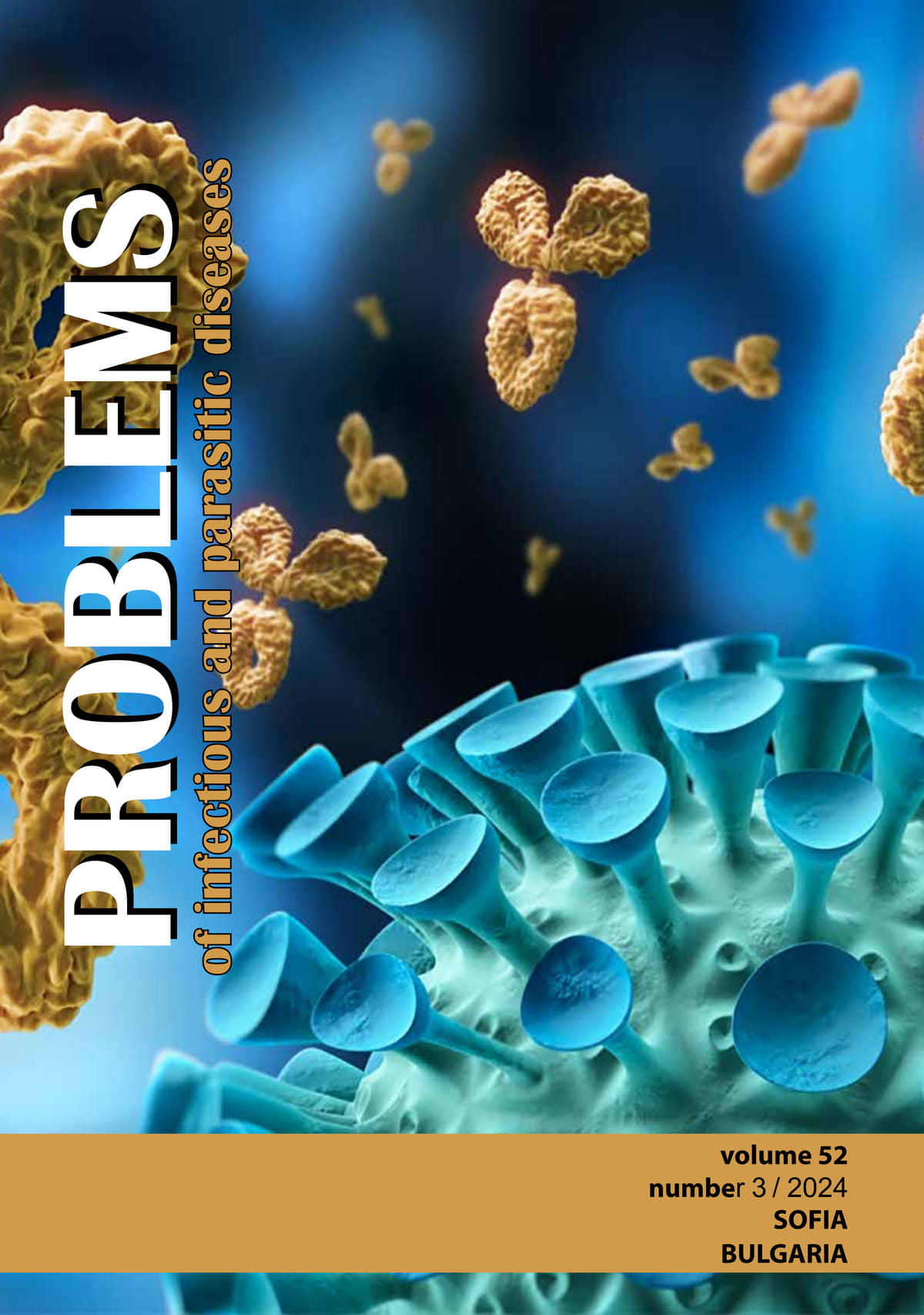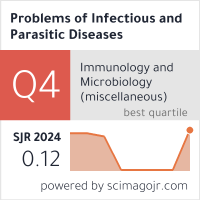SALIVARY SPECIFIC IgE TO D1 AND G6 IN PATIENTS WITH RHINITIS WITH OR WITHOUT S. AUREUS COLONIZATION
DOI:
https://doi.org/10.58395/fxa59569Keywords:
mucosal specific IgE, systemic specific igE, local allergic rhinitis, S. aureus colonization, IgE productionAbstract
Globally, allergic rhinitis impacts roughly 25% of children and 40% of adults. Immunoglobulin E (IgE) plays a crucial part in allergic inflammation, with two sources: spontaneously produced IgE, and IgE stemming from reactions to environmental allergens. The damaging effects of S. aureus, as well as Staphylococcal enterotoxins (Ses), have been proven in numerous airway illnesses. As superantigens, Ses generate intense Th2 inflammation, with 70-80% of IgE being locally synthesized. Our study aimed to determine if any correlation existed between local and systemic specific IgE responses in rhinitis patients – both treated and untreated. Furthermore, we sought to pinpoint significant disparities in serum allergy-specific IgE levels between S. aureus positive and negative patients.
Results: From 70 patients with a relevant rhinitis history spanning at least two years, we found that in our rhinitis cohort, 36 were sIgE-negative for d1 in blood samples but positive in saliva samples (χ2 = 19.76, α = 0.181), while 25 tested negative for g6 in blood samples but positive for g6 in saliva samples (χ2 = 6.89, α = 0.86). No significant difference emerged between serum allergy-specific IgE levels in S. aureus positive and negative rhinitis patients (χ2 = 0.38). Similar results were noted within the saliva samples. However, mucosal-specific IgE levels were lower among patients receiving active therapy (p < 0.001 for both d1 and g6).
Conclusion: There is no correlation between mucosal-specific IgE levels and systemic-specific IgE levels or S. aureus carriers. We observed that salivary-specific IgE levels were lower in patients undergoing active treatment compared to untreated patients.
Downloads
References
1. Nur Husna, S.M., et al., Allergic Rhinitis: A Clinical and Pathophysiological Overview. Front Med (Lausanne), 2022. 9: p. 874114. https://doi.org/10.3389/fmed.2022.874114
2. Deacy, A.M., S.K. Gan, and J.P. Derrick, Superantigen Recognition and Interactions: Functions, Mechanisms and Applications. Front Immunol, 2021. 12: p. 731845. https://doi.org/10.3389/fimmu.2021.731845
3. Flora, M., et al., Staphylococcus Aureus in chronic airway diseases: An overview. Respir Med, 2019. 155: p. 66-71. https://doi.org/10.1016/j.rmed.2019.07.008
4. ravers, J. and M.E. Rothenberg, Eosinophils in mucosal immune responses. Mucosal Immunol, 2015. 8(3): p. 464-75. https://doi.org/10.1038/mi.2015.2
5. Huby, R.D., R.J. Dearman, and I. Kimber, Why are some proteins allergens? Toxicol Sci, 2000. 55(2): p. 235-46. https://doi.org/10.1093/toxsci/55.2.235
6. De Schryver, E., et al., Local immunoglobulin e in the nasal mucosa: clinical implications. Allergy Asthma Immunol Res, 2015. 7(4): p. 321-31. https://doi.org/10.4168/aair.2015.7.4.321
7. Cantone, E., A. Detoraki, and E. De Corso, Local Allergic Rhinitis: A Different Rhinitis Endotype? Literature Overview. Applied Sciences, 2022. 12(21). https://doi.org/10.3390/app122111141
8. Mortada, M.M. and M. Kurowski, Challenges in Local Allergic Rhinitis Diagnosis, Management, and Research: Current Concepts and Future Perspectives. Medicina (Kaunas), 2023. 59(5). https://doi.org/10.3390/medicina59050929
9. Rondon, C., et al., IgE Test in Secretions of Patients with Respiratory Allergy. Curr Allergy Asthma Rep, 2018. 18(12): p. 67. https://doi.org/10.1007/s11882-018-0821-7
10. KleinJan, A., et al., Local production and detection of (specific) IgE in nasal B-cells and plasma cells of allergic rhinitis patients. Eur Respir J, 2000. 15(3): p. 491-7. https://doi.org/10.1034/j.1399-3003.2000.15.11.x
11. Bousquet, J., et al., Rhinitis associated with asthma is distinct from rhinitis alone: The ARIA-MeDALL hypothesis. Allergy, 2023. 78(5): p. 1169-1203. https://doi.org/10.1111/all.15679
12. Matricardi, P.M., The Very Low IgE Producer: Allergology, Genetics, Immunodeficiencies, and Oncology. Biomedicines, 2023. 11(5). https://doi.org/10.3390/biomedicines11051378
13. Williamson, S., et al., Comparison of biomarkers in blood and saliva in healthy adults. Nurs Res Pract, 2012. 2012: p. 246178. https://doi.org/10.1155/2012/246178
14. Eckl-Dorna, J., et al., Tracing IgE-Producing Cells in Allergic Patients. Cells, 2019. 8(9). https://doi.org/10.3390/cells8090994
15. Terada, T. and R. Kawata, Diagnosis and Treatment of Local Allergic Rhinitis. Pathogens, 2022. 11(1). https://doi.org/10.3390/pathogens11010080
16. Spaulding, A.R., et al., Staphylococcal and streptococcal superantigen exotoxins. Clin Microbiol Rev, 2013. 26(3): p. 422-47. https://doi.org/10.1128/CMR.00104-12
17. Abdurrahman, G., et al., Allergy-A New Role for T Cell Superantigens of Staphylococcus aureus? Toxins (Basel), 2020. 12(3). https://doi.org/10.3390/toxins12030176
18. Shaghayegh, G., et al., S. aureus biofilm metabolic activity correlates positively with patients' eosinophil frequencies and disease severity in chronic rhinosinusitis. Microbes Infect, 2023. 25(8): p. 105213. https://doi.org/10.1016/j.micinf.2023.105213
19. Hohchi, N., et al., Synergism of Staphylococcus aureus colonization and allergic reaction in the nasal cavity in mice. Int Arch Allergy Immunol, 2012. 159(1): p. 33-40. https://doi.org/10.1159/000335200
20. Gloudemans, A.K., B.N. Lambrecht, and H.H. Smits, Potential of immunoglobulin A to prevent allergic asthma. Clin Dev Immunol, 2013. 2013: p. 542091. https://doi.org/10.1155/2013/542091
21. Miranda, D.O., et al., Serum and salivary IgE, IgA, and IgG4 antibodies to Dermatophagoides pteronyssinus and its major allergens, Der p1 and Der p2, in allergic and nonallergic children. Clin Dev Immunol, 2011. 2011: p. 302739. https://doi.org/10.1155/2011/302739
22. Santamaria, L., et al., Nasal specific IgE to Der p is not an acceptable screening test to predict the outcome of the nasal challenge test in patients with non-allergic rhinitis. World Allergy Organ J, 2020. 13(9): p. 100461. https://doi.org/10.1016/j.waojou.2020.100461
23. Egger, C., et al., Effects of nasal corticosteroids on boosts of systemic allergen-specific IgE production induced by nasal allergen exposure. PLoS One, 2015. 10(2): p. e0114991. https://doi.org/10.1371/journal.pone.0114991
24. Wilson, D.R., et al., Grass pollen immunotherapy inhibits seasonal increases in basophils and eosinophils in the nasal epithelium. Clin Exp Allergy, 2001. 31(11): p. 1705-13. https://doi.org/10.1046/j.1365-2222.2001.01231.x
25. Wachholz, P.A., et al., Grass pollen immunotherapy for hayfever is associated with increases in local nasal but not peripheral Th1:Th2 cytokine ratios. Immunology, 2002. 105(1): p. 56-62. https://doi.org/10.1046/j.1365-2567.2002.01338.x
26. Kerzerho, J., et al., Effects of systemic versus local administration of corticosteroids on mucosal tolerance. J Immunol, 2012. 188(1): p. 470-6. https://doi.org/10.4049/jimmunol.1101405
Downloads
Published
Issue
Section
License
Copyright (c) 2025 Diana Hristova, Antoaneta Decheva, Deyan Donchev, Damyan Vangelov, Vancho Donev, Georgi Nikolov, Maria Nikolova (Author)

This work is licensed under a Creative Commons Attribution 4.0 International License.






